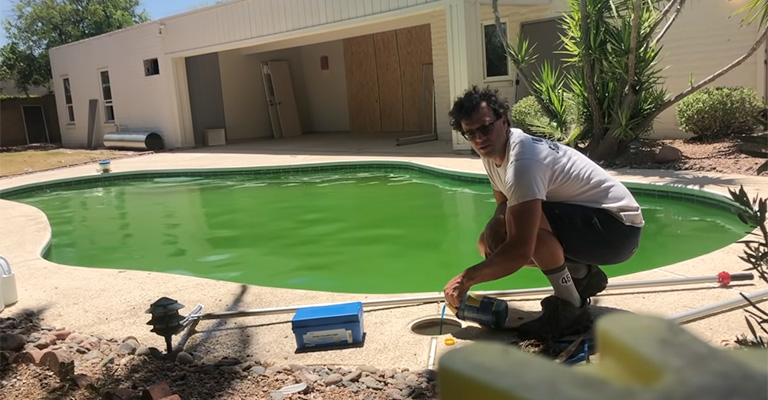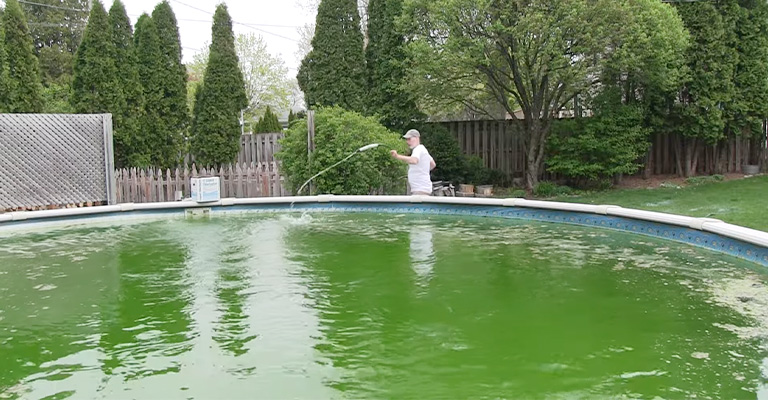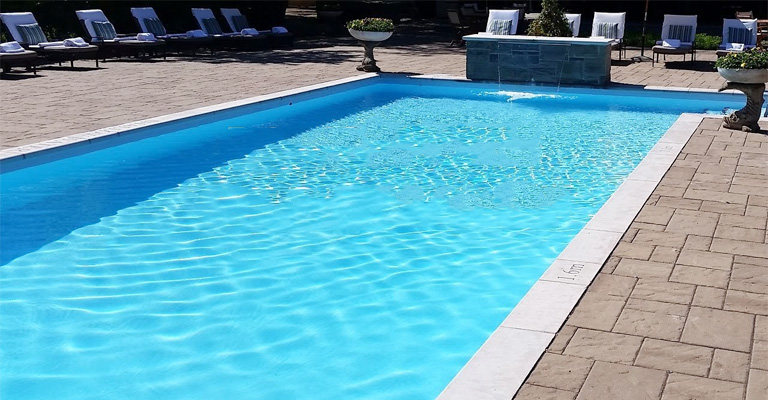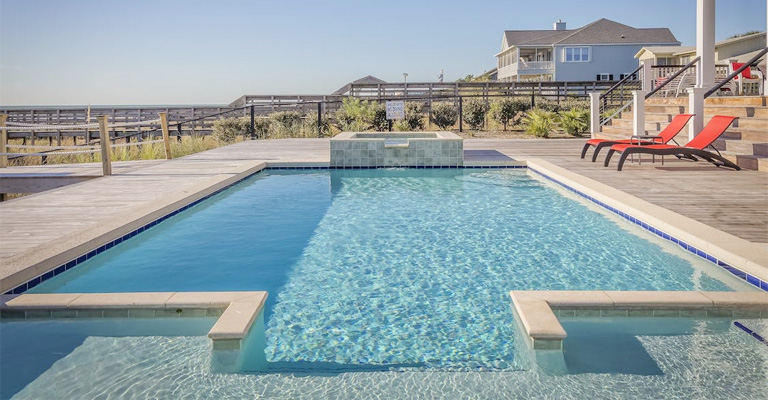Maintaining a properly chlorinated pool is vital for keeping the water safe, sanitized, and inviting.
However, pool owners occasionally encounter an issue known as chlorine lock, where chlorine becomes ineffective in killing bacteria and algae.
If you’ve ever wondered, “Will chlorine lock fix itself?” you’re not alone. Understanding this common problem and its potential solutions is key to maintaining a healthy swimming environment.
By partially draining your pool, you can combat chlorine lock caused by excessive cyanuric acid levels. There is no cost-effective way to drain out cyanuric acid since it doesn’t dissipate.
If the water level drops below your skimmer level, you should use a submersible pump or a venturi pump to prevent your pool pump from burning out.
What Is a Chlorine Lock?
There is a theory floating around that cyanuric acid inhibits chlorine’s function. It is believed that, once this occurs, chlorine can’t act as a sanitizer because it is “locked up.”
This isn’t real. It’s for this reason that cyanuric acid is also referred to as a chlorine stabilizer.
Because it prevents chlorine from breaking down in sunlight as quickly as it would if it wasn’t stabilized, it actually helps chlorine to do its job. Are there any limits to the amount of stabilizer you can add to your pool? Yes, of course.
Any chemical in your pool can be too much. To keep the water balanced, perform regular pool water testing according to the manufacturer’s instructions.
What Is Chlorine Demand?
Here’s the real deal. The effectiveness of chlorine is limited. More chlorine is required to properly sanitize the water if there are a lot of bathers or debris in the pool.
Therefore, more chlorine is needed to combat those materials in the water. A situation like this is called chlorine demand. There aren’t many cases like this, but they do happen.
Does Chlorine Lock Go Away By Itself?
No. Occasionally, rain can dilute your pool water and lower CC and cyanuric acid levels, but in reality, chlorine locks can only be broken actively.
All About Chlorine Lock And How Do You Break It

You might have walked past a pool and gotten a whiff of an intense chlorine or chemical smell and thought, “Oh, there is too much chlorine in the pool.” Well, the exact opposite is happening here.
If your pool smells strongly of chlorine, you probably have a lot of chlorine amines. Chloramines are a chemical compound formed when organic matter (sweat, pee, urine) mixes with chlorine disinfectant chemicals.
What is the significance of this? Your pool’s sanitizing power can be gauged by the presence of a lot of chloramines.
In either case, a buildup of chloramine means that your chlorine isn’t working properly or there isn’t enough chlorine in your pool to destroy them.
What Does This Have To Do With Chlorine Lock?

If your free chlorine reading is wildly divergent from your total chlorine level, this is known as a chlorine lock.
Total chlorine refers to the total amount of chlorine in your pool while free chlorine refers to how much chlorine is actually “working” to sanitize it.
If the total chlorine is much higher than the free chlorine, they should roughly be the same or very close.
Warning: Many people mistake the chlorine smell for too much chlorine and stop treating their pools, this is a huge mistake.
What Exactly Is A Chlorine Lock?
It refers to a situation where your chlorine is rendered ineffective and no matter how much chlorine you add, it won’t work and free chlorine levels won’t increase.
Your pool’s cyanuric acid or stabilizer is one of the main causes. Too much cyanuric acid will render your chlorine ineffective and useless, even though it protects it from UV rays.
How Do You Break Chlorine Lock?

Good news: fixing this problem is relatively simple. Water only needs to be super chlorinated. Shocking your pool is the fastest way to accomplish this. You don’t usually do it the normal way.
The best method is to shock it three times with calcium hypochlorite. In order to triple shock water, add three pounds of shock per 10,000 gallons. In order to do this correctly, you’ll need to know the volume of your pool.
Make sure the chlorine stabilizer level is between 30 ppm and 80 ppm before adding the shock, with 50 ppm being ideal.
You should also shock at night because sunlight reduces the effectiveness of chlorine, which is why you’re using a stabilizer.
Using a Cyanuric Acid Reducer
Enzyme compounds can reduce the levels of cyanuric acid in your pool without needing to drain it and rebalance your chemicals.
Partially Draining Your Pool

It is only possible to partially drain your pool to resolve chlorine lock caused by too much cyanuric acid. Due to the fact that cyanuric acid doesn’t dissipate, draining it out is the only cost-effective method for removing it.
To prevent your pool pump from burning out or running dry once the water level has dropped below your skimmer levels, we recommend using a submersible or venturi pump.
You should take out about 1/4 of the water from your pool and then refill it with fresh water. Check your chemical levels again after allowing the water to circulate for at least eight hours.
You should have experienced a significant drop in cyanuric acid levels as well as a significant drop in chlorine levels.
Check your free chlorine levels after adding chlorine to see if they go up as expected. Try it one more time if this doesn’t work. Chlorine locks can be solved in this way.
As you are throwing out a large portion of your pool chemicals with your water, this procedure is very time consuming and consumes a lot of pool chemicals.
What Causes Chlorine Demand?
When you open your pool in the spring, you may also encounter this problem due to bather loads and debris.
It may have accumulated quite a bit of organic contaminants in the water during the winter, due to the fact that it was stagnant and untreated. It will take a lot of chlorine to neutralize them.
In addition, this could happen if the pool has been neglected for a long time or has not been properly cared for.
Depending on the chemical makeup of rainwater, heavy rainfall can also be a factor. After a rainstorm, if you can’t maintain a chlorine reading, chances are you have chlorine demand.
It is possible for runoff to introduce contaminants into the water that will consume all the chlorine. The pool should not be exposed to fertilizers or other chemicals not designed for swimming pools.
Achieving Breakpoint Or Break-Even Chlorination
Other ways of breaking chlorine locks include achieving what is called breakpoint or break-even chlorination. In other words, you’ll be adding enough chlorine to oxidize everything in the pool that’s causing the lock.
You need to do some accurate calculations here because if you’re not reaching breakpoint chlorination, you’re simply making things worse.
Preventing Chlorine Locks
Monitoring your chlorine and cyanuric acid levels constantly is the best way to prevent chlorine lock.
Use unstabilised chlorine only when your cyanuric acid levels are close to maximum recommendations and do not exceed them.
Keep your chlorine levels above the recommended levels as well. It might be a good idea to get a salt water chlorinator if you aren’t able to keep on monitoring your chlorine levels.
You can monitor your chlorine levels without the hassle and effort of using a salt water chlorinator.
Whenever you plug it in, it will continually chlorinate your pool water, preventing chloramines from building up and chlorine locks from occurring.
Since the chlorinator constantly adds chlorine to your pool, you do not have to monitor your cyanuric acid levels as often.
Are Chlorine Lock and Chlorine Demand the Same Thing?
Sometimes these terms are used interchangeably, but they are not the same thing. Your pool’s chlorine demand can be satisfied by adding enough chlorine to it until the test kit or strip registers a reading.
A false issue called chlorine lock is often referred to by pool companies and experts when they really mean chlorine demand (should be called chlorine lock).
Adding more chlorine to your pool is the only way to solve chlorine lock if a pool pro tells you the problem exists.
It wouldn’t last long anyway. If you act swiftly, chlorine demand will not increase. Don’t let chlorine lock distract you from addressing problems that may develop, or from enjoying your well-kept pool.
The Bottom Line
Whenever your pool smells strongly of chlorine, test your water to see if your combined and free chlorine levels are close.
A chlorine lock can be prevented if unstabilised chlorine is added or your pool is shocked early enough. Alternatively, you can get a salt water chlorinator to prevent a chlorine lock more hands-off.
You can use a pool chemical to lower your cyanuric acid levels effectively if you want to remove a chlorine lock safely and quickly.







